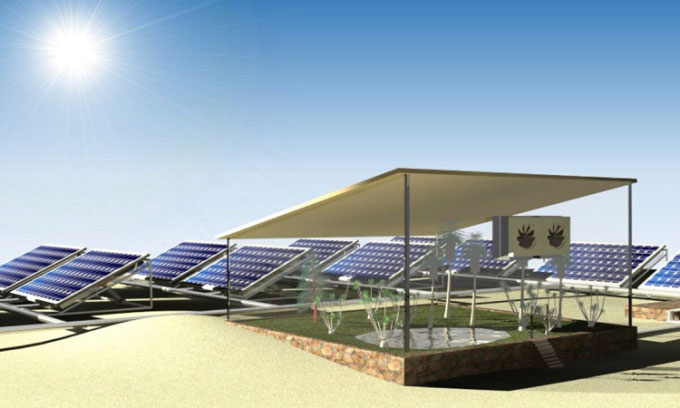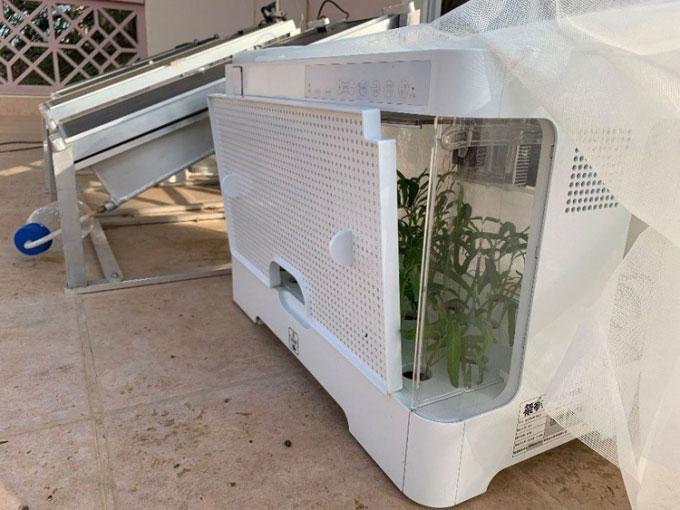The system produces both solar power and water in the desert
The WEC2P system consists of a solar cell and a hydrogel layer that absorbs moisture in the air, and can operate day and night.

Simulation of a large-scale water and solar power generation system in the desert.
In remote desert areas, electricity and water for agriculture are two things that are often in short supply. A team of scientists at King Abdullah University of Science and Technology (KAUST), Saudi Arabia, has developed a new system that addresses both of these problems by combining solar panels with an absorbing hydrogel layer, placing it called the integrated crop-water-electricity-production system, or WEC2P. The new study was published in the journal Cell Reports Physical Science on March 1.
WEC2P consists of a series of interconnected solar cells, each on top of a hydrogel layer. The battery and the hydrogel together form the lid of a metal canister with a sloping face, under which is a faucet. At night, leave the box open, allowing the hydrogel to draw moisture from the air. During the day, the box is closed. Solar cells will produce electricity when sunlight shines on. This amount of sunlight also causes both the solar cell and the hydrogel layer below to heat up.
As a result, the previously absorbed water evaporates up from the hydrogel layer and condenses on the back of the panel. As liquid water flows out of the battery, it carries away excess heat and provides a cooling effect, making the solar cell up to 9% more efficient. The water then flows to the bottom of the metal can and to the faucet. From here, the user can collect water to use for irrigation or drinking.

The test system consists of two solar panels and a planter box.
Experts conducted a small-scale test with WEC2P in the desert of Saudi Arabia for about two weeks last June. With solar cells and a desk-sized hydrogel layer, the test system generated a total of 1,519 Wh of electricity and about 2 liters of water. This amount of water is used to irrigate 60 spinach seeds grown in plastic containers. In which, 57 seeds have germinated and grown 18 cm high.
"Ensuring everyone on Earth has access to clean water and clean energy at affordable prices is part of the Sustainable Development Goals (SDGs) set by the United Nations. I hope the new design has something to do with it. can become a decentralized electricity and water production system to light houses and water plants," said Professor Peng Wang, a member of the research team.
- The world's largest solar power plant
- Build miniature solar system in the desert
- Build solar fields in the Sahara desert to power Europe
- The Sahara Desert can turn into a giant power plant
- The Solar System's water was born before the Sun.
- New trend: Solar power floats on water
- The solar power plant is made of 10,000 giant mirrors
- The world's largest solar power plant comes into operation
- India turns the desert into a solar 'oasis'
- Does the Sahara become a giant solar plant?
- Use solar power with high technology
- America built the world's tallest solar power tower
 'Barefoot engineer' invents a pipeless pump
'Barefoot engineer' invents a pipeless pump Process of handling dead pigs due to disease
Process of handling dead pigs due to disease Radiometer
Radiometer Warp Engine: Technology brings us closer to the speed of light
Warp Engine: Technology brings us closer to the speed of light How do marine animals drink filtered water?
How do marine animals drink filtered water?  Discover the secret of the water buffalo
Discover the secret of the water buffalo  Shocking discovery about the Earth's 'tail'
Shocking discovery about the Earth's 'tail'  Top 10 Unbelievable Ways Animals Survive in Dangerous Environments
Top 10 Unbelievable Ways Animals Survive in Dangerous Environments  Mysterious wonders of the world
Mysterious wonders of the world  The largest animals that lived in the desert, still exist today
The largest animals that lived in the desert, still exist today 